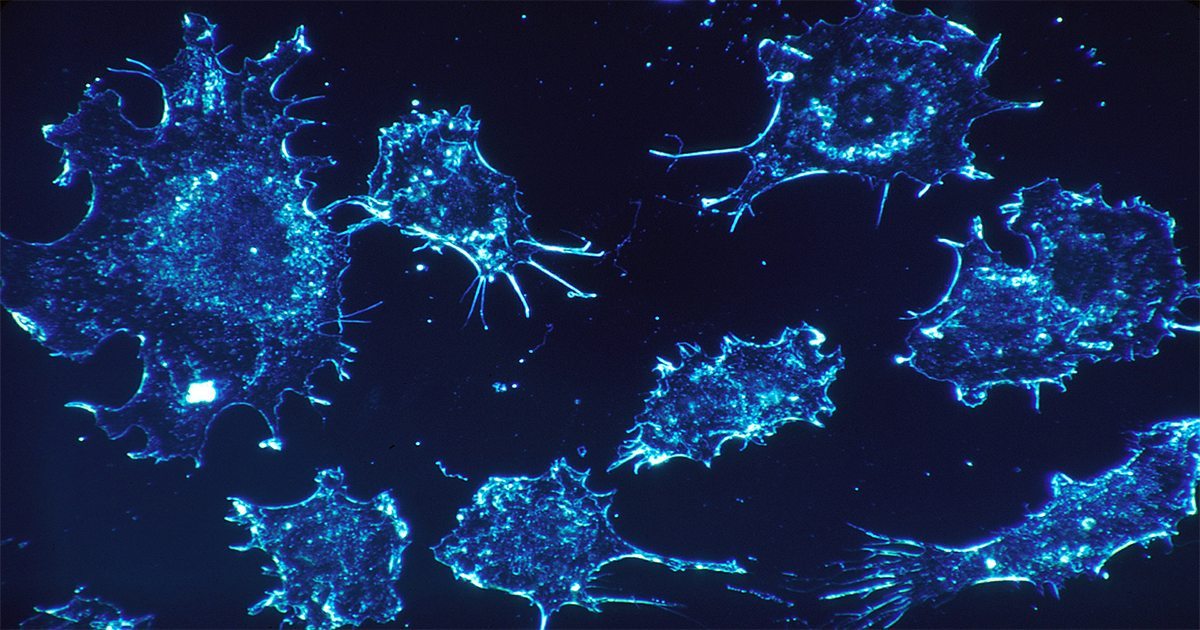Category: Mesothelioma Diagnosis

The Potential of Nanoparticles in Treatment of Mesothelioma Patients
In May, Mesothelioma Help reported that researchers from the University of North Carolina Lineberger Comprehensive Cancer Center found a “promising new nanotechnology-based delivery method” for immunotherapy using nanoparticles. Now, another team of researchers report they have found a way to use this microscopic drug delivery system “for diagnostics, therapy, or both” for cancer care.
In the latest research from the Moscow Institute of Physics and Technology (MIPT), a team of biophysicists report they engineered a way to cover nanoparticles with biological molecules that allows them to deliver therapy and then examine the effect the drug has on the cancer cells. The particles, for example, can carry properties that can home in on the cancer cells to pinpoint the therapy as well as fluorescent properties to light up the cancer cells for diagnostics.
Using theranostics, the integration of therapeutics and diagnostics, in mesothelioma care is an exciting prospect. Most of the treatments used for mesothelioma, a terminal asbestos-caused cancer, eventually become ineffective, but it may not be discovered until the mesothelioma cancer is no longer treatable. With diagnostic capabilities embedded in the nanoparticles, the effectiveness of the treatment can be monitored as needed.
The researchers developed a “molecular glue” using the barnase-barstar protein pair to hold the therapeutic and diagnostic components together. The success of this research is due to this glue that can bind up to one million times greater than other types, and can bind with antibodies, drugs, fluorescent molecules and targeting agents. When the two proteins are tightly bound they form “a bifunctional compound” with both therapeutic and diagnostic properties, that enables targeted drug delivery.
This type of personalized medicine follows the concept that the cancer’s genetic makeup can be used to tailor a patient’s treatment. Mesothelioma can grow at a different rate and respond to different treatments in each patient, that is why mesothelioma patients need treatment that is aimed at their unique characteristics. By allowing the therapeutic aspect of the nanoparticles to be modified, this personalized care optimizes the potential for success of the treatment.
“The demonstrated capabilities show this method to be a promising alternative to commonly used … techniques in nanobiotechnology, theranostics, and clinical applications,” wrote the authors in the study published in ACS Applied Materials & Interfaces.
Mesothelioma, a rare form of cancer typically affecting the lining of the lungs, is highly aggressive and is resistant to many cancer treatments making it a difficult disease to treat effectively. The prognosis for mesothelioma patients is usually grim: the average survival time varies from 4 – 18 months after diagnosis. Approximately 3,000 Americans are diagnosed with mesothelioma each year.
The paper was published in the April 27 issue of the journal ACS Applied Materials & Interfaces.

“Lung Decision Precision” Screening Tool May Lead to Early Detection of Mesothelioma
The key to increased life expectancy when battling lung cancer, and other extremely aggressive cancers such as mesothelioma, is early detection. Unfortunately, while there are standard screening tests and guidelines for breast cancer, colon, and prostate cancer, lung cancer screening tests are limited to high risk patients, defined as life-long heavy smokers. Now, researchers have developed a personalized lung cancer screening decision tool which incorporates past asbestos exposure as a criteria to guide individuals and physicians in determining their lung cancer screening options.
Researchers from the University of Michigan have unveiled a lung cancer screening Q&A tool that can be used by medical professionals to identify people who may benefit from a low-dose computed tomography (LDCT) screening. For people who do not have any symptoms often associated with lung cancer or pleural mesothelioma, such as difficulty breathing, coughing or fatigue, there is seemingly no reason to screen for lung cancer.
That is why the personalized Lung Decision Precision tool for physicians, which presents a series of questions targeting the person’s smoking history and asbestos exposure, is important. The tool is designed to open discussion between the physician and patient to determine whether a lung screening is appropriate.
“This allows us to identify which patients are in the preference-sensitive zone for the decision about screening, and which ones have a very clear potential benefit to them,” said Tanner Caverly, M.D., M.P.H., an assistant professor in the Division of General Medicine and Department of Learning Health Sciences at the U-M Medical School.
The Lung Decision Precision Tool asks the critical question: “Has the patient been exposed to asbestos at work?” Based on a “yes” answer, the patient is asked to confirm the following:
- You worked in one or more of the following occupations: asbestos worker, insulator, lagger, plasterboard worker, dry waller, plasterer, ship scaler, ship fitter, rigger, shipyard boilermaker, shipyard welder, shipyard machinist, shipyard coppersmith, shipyard electrician, plumber/pipefitter, steamfitter, or sheet metal worker.
- You worked in this job for at least 5 years.
- You began working in this job at least 15 years ago.
Asbestos is a human carcinogen, known to cause lung cancer and pleural mesothelioma, a cancer of the lining of the lungs diagnosed in nearly 3,000 Americans each year. The U.S. Environmental Protection Agency warns that there is no safe level of exposure. In addition, the Occupational Safety and Health Administration reports, “every occupational exposure to asbestos contributes to the risk of getting an asbestos related disease.”
While no longer used in new buildings in the U.S., asbestos was added to a variety of products including insulation, steam pipes, furnace ducts, floor tiles and roofing shingles, in buildings and homes built prior to EPA regulations were put in place in the 1970’s. People who worked in construction, ship-building, plumbing and in the military are at a higher risk than others of developing mesothelioma.
The only recommended screening test for lung cancer is LDCT, according to the Centers for Disease Control and Prevention. During an LDCT an X-ray machine scans the body and uses low doses of radiation to make detailed pictures of the lungs to help find abnormal areas that may be cancer. The American Cancer Society reports that in a study of 50,000 smokers or former smokers aged 55 to 74 researchers found that people who got LDCT had a 20% lower chance of dying from lung cancer than those who got chest x-rays.
Mesothelioma is often not diagnosed until symptoms are present, and the cancer is in its late stages. At this point, prognosis is often less than one-year. Stopping tumor growth and preventing metastasis is especially critical for mesothelioma and lung cancer where the diseases are highly aggressive. This can only be achieved if the mesothelioma cancer is detected early.
“As a clinician I’d like to have this [tool] for many of the things I do, where it would be meaningful to know how beneficial something could be for the individual patient, and we could talk about whether it’s indicated for them,” said Caverly.
The research team also launched a companion website, “Should I get screened”, for patients that includes easy-to-understand information about the pros and cons of lung cancer screening, and includes a “lung cancer risk calculator.”
If you have been exposed to asbestos in the past, talk to your doctor about the Lung Decision Precision tool.
Find out more about the tool in the May 29 issue of Annals of Internal Medicine.
Sources:
- University of Michigan
http://ihpi.umich.edu/news/scan-or-not-scan-research-shows-how-personalize-lung-cancer-screening-decisions - Annals of Internal Medicine
http://annals.org/aim/article-abstract/2682684/identifying-patients-whom-lung-cancer-screening-preference-sensitive-microsimulation-study - Lung Decision Precision tool
https://share.lungdecisionprecision.com/ - Should I get screened
http://www.shouldiscreen.com/ - The American Cancer Society
https://www.cancer.org/cancer/lung-cancer/prevention-and-early-detection/early-detection.html - Occupational Safety and Health Administration
https://www.osha.gov/SLTC/asbestos/

Emotional Stress Of Mesothelioma Diagnosis Could Lead to PTSD
MesotheliomaHelp has reported time and again about the stress mesothelioma patients face. Trying to handle treatments in the midst of managing bills, insurance, appointments and communication with friends and family can take its toll. Now, researchers report the emotional impact of dealing with a cancer diagnosis is even more serious than previously reported.
A team of Malaysian researchers report that nearly one-fifth of cancer patients are likely to suffer from post-traumatic stress syndrome (PTSD) after their diagnosis, according to a Nov. 20 article in MedPage Today. In their study of just over 200 patients, they found that more than 20% of cancer patients had symptoms of PTSD a month after diagnosis. About 33% of those patients were still struggling with PTSD four years later.
“Our data underscore the risk of developing persistent PTSD even years after mesothelioma cancer diagnosis and treatment,” said Lei Hum Wee, PhD, of the National University of Malaysia in Kuala Lumpur.
The team from Kuala Lumpur is not the first to identify PTSD in cancer patients, however, they are the first to use gold-standard clinical interviews and to follow a cohort for as long as four years. With the cancer diagnosis being the traumatic exposure, to be diagnosed with PTSD a patient must also have had “at least one recurring symptom, three avoidance/numbing symptoms, and two arousal symptoms, all persisting for more than a month and resulting in significant distress or functional impairment.” For subsyndromal PTSD the patient’s response must lead to distress or functional impairment persisting more than a month, associated with the presence of at least six symptoms from three of four categories (recurring, avoidance/numbing, hyperarousal, and duration), according to the researchers.
Numerous studies have shown that if after a terminal cancer diagnosis a patient does not receive proper support managing the vast number of issues they are faced with, such as financial issues, transportation needs, personal care and family management, the stress can lead to depression, anxiety and failing health. In fact, according to a 2007 breakthrough study conducted by the Institute of Medicine, physicians should also monitor the social and emotional health, or psychosocial needs, of patients to lessen their suffering and to “support their return to health.” The IOM report stressed that, “Psychosocial issues in cancer are palpable, important, and potentially crippling.”
The researchers in the current PTSD study reported that for the patients in their study, a cognitive behavioral therapy had “significant improvement in anxiety and distress associated with fear of cancer recurrence.” Mesothelioma patients should discuss treatment options for their mental health with their oncologist. Treating the emotional aspect of mesothelioma should not be ignored.
“This [study] highlights a need to monitor PTSD among long-term cancer survivors, especially because many of the symptoms of PTSD, such as avoidance and cognitive difficulties (as well as psychological distress), are enduring, which may potentially impact adherence to treatment,” said Dr. Lei Hum Wee.
Nearly 3,000 Americans are diagnosed with mesothelioma each year.

Congratulations and Thanks to Memorial Sloan Kettering Cancer Center
Memorial Sloan Kettering Cancer Center in New York City was recently rated the best cancer hospital in the United States by U.S. News and World Report. Dad was blessed to participate in a clinical trial with Dr. Lee Krug of MSKCC. How amazing to have had the opportunity to be treated at the #1 location in the country!
All of the doctors and staff that Dad encountered at MSKCC were amazing. They were compassionate, friendly, understanding, and knowledgeable; all qualities necessary for helping cancer patients and their families. Anyone who has gone through a tough medical situation can appreciate how important these qualities are in a care team, and this group is a paramount example.
Congratulations to the entire staff at Memorial Sloan Kettering, what a well-deserved honor! Thank you for all the life-saving work that you do on behalf of my family and all those lives you have touched!
Know more about Mesothelioma and how you can deal with it.

Anxiety Before Followup Mesothelioma Scan
The following post is Part I of an article from Jan Egerton, a long-time mesothelioma survivor. Jan has suffered many setbacks during her battle with mesothelioma, and here she discusses her last struggle with chemotherapy and the anxiety leading up to her CT scan.
After a terrible few weeks leading up to the appointment for my followup CT scan, I had set my mind that no matter what, I was having chemotherapy for the third time. I was dreading the chemotherapy, but with the choice of something that could work against me or only one trial on offer in the UK what choice did I have?
I still class myself as a healthy person, the only thing wrong with me is mesothelioma, and okay, this annoying bile problem that has developed over the years from a mixture of the side effects of chemo and having my gall bladder removed to prove a point. [Jan has been struggling with bile buildup in her stomach.] I have found I don’t ail from the normal things that people without cancer do.
On the eve of my first chemotherapy infusion I started with one of my “sessions”, this is when my mesothelioma is on the warpath and does a kind of growing surge, at least that’s what I say. My temperature drops to around 35.3C [95.5F], I can’t get comfortable and I feel like my adrenalin is pumping. When they took my temperature before commencing the infusion, again showing it was low, I was worried they wouldn’t go ahead, but I told the nurse it would be alright I was having a “mesothelioma growth spurt.”
I knew the minute the chemotherapy started pumping through my veins it would do some damage [to the cancer cells], even at the low dose of 50% of what my body could handle. That night my body hurt, each area where my mesothelioma resides told me it wasn’t happy, I could imagine each tumour opening like a flower to send its seeds out and the chemo creeping in and killing all the seeds. It was a full out war going on inside.
The second infusion wasn’t a good one [November, 2012], my body took a dislike to the carboplatin as it was pumping through my veins, and I found myself in an ambulance being transferred to a hospital with an A & E department. Needless to say that was the last chemotherapy I was allowed.
Now I really dreaded the upcoming CT scan: my aches and pains were worse, my imaginary steel cage that tightens around my left ribs had turned to a solid iron one, each movement feeling restricted, my back ached and I felt dreadful. My bile problem had also increased in intensity, and I was sure when I finally had my CT scan, some two months after my second infusion, it was going to be extremely bad news.
I was giving myself a year at most, so I looked at projects I wanted to get done before I was too ill to complete them. My life with my husband was the most important one, creating a storyboard of our time together, the happy times, the dogs we have poured our love on, the holidays we have had – I wanted it all mapped out and put onto DVD’s so if he wanted to remember me all he had to do was press play.
Read Part II of Jan’s story next week to find out the results of her scan.
Know more about mesothelioma and how we can help.
Free Mesothelioma Patient & Treatment Guide
We’d like to offer you our in-depth guide, “A Patient’s Guide to Mesothelioma,” absolutely free of charge.
It contains a wealth of information and resources to help you better understand the condition, choose (and afford) appropriate treatment, and exercise your legal right to compensation.
Download Now